A second round of Everest reissues is the cue for a sequel to
my first group review. Do also watch out for assessments of individual discs already on MusicWeb International or in the pipeline, and there is also my colleague
John Whitmore's recent survey.
The Everest label means that we are talking about recordings dating back to the late 1950s and in some cases extending into the 1960s. They first emerged as commercial reel-to-reel tapes and vinyl long players. That said, these CDs derive from original vintage studio masters on magnetic stock.
Once again those I have selected are, for the most part, well recognised recordings .... at least to older hands. They are in good stereo, a little prone to spotlighting but nothing disagreeably extreme. All the sessions derive from 1958 and Walthamstow Assembly Hall. Those sessions and the logistics for them must have been quite something. I wonder if everything went as smoothly as the results might suggest.
The disc covers are the by now familiar brand of 1960s kitsch for which we can now feel a degree of nostalgic affection.
The LP origins declare themselves in the shorter playing time by comparison with mainstream CD production these days and with earlier 2000s reissues on Omega. It’s sad, though, that the total playing times are not declared anywhere. You have to add up the individual track-timings.
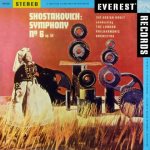
The
Shostakovich Sixth Symphony plays for just 32.49. It has no coupling at all. The searchlight turns on Boult and the LPO, captured in 1958 in that splurge of recording sessions in Walthamstow. Boult's steely concentration works very well. He drives a specially intense reading at a time when recordings of the Sixth were rare. As for the LPO, its thrumming and piercing intensity showed the orchestra at that stage every bit the equal of the 1970s LSO - the leading non-Russian Soviet-style orchestra in the right hands. The kindled smoke and sparks may not rise with quite the crackle and ferocity that they do with
Mravinsky reading of No. 6 but it's still gripping playing. The grumble and grunt of the double basses at the centre of the massive first movement is testimony to this, quite apart from the great arching string oration of the work's opening. The sardonic cackling and shrieking of the following two movements may not be quite as caustic as the likes of
Kondrashin and Mravinsky but ring with conviction. This is invaluable as a document of how the seasoned post-BBCSO years' Boult was still a far from spent force. The recording is remarkably clean, un-hissy to my ears, yet with plenty of treble penetration. We are told that the notes by Richard Hall — in English only — are the originals used with the LP. It is my shortcoming that I still struggle with a work that matches up a searing and massively striding first movement, where the excoriating strings strip paint, with two circus jape movements. The latter pair - anti-Stalin satire as people would have us believe, though I have my doubts - are brilliant.
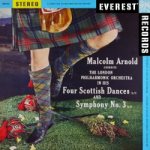
Turning to the
Malcolm Arnold disc we encounter the LPO again; this time with Arnold conducting. This is the composer in vigorously triumphant mode. It's a pity that we are denied a declaration of total timings on the back of the CD case - in this instance we are talking about circa 55 minutes - longer than many of the new Everests.
Paul Affelder's liner essay brings in quotations from the composer. These remain objectively descriptive. He's giving nothing away about personal impulse or inspiration. Affelder's original notes are caught in jet with the composer then having written three symphonies rather than the nine he completed - ten if you include the Symphony for Brass and eleven if you embrace the attractive Symphony for Strings. Let's not be tempted to add the three Sinfoniettas.
The
Scottish Dances are heard in good clean sound with lots of close-up detail. The boozy fumes of the lurching second dance fill the listening room with shades of Arnold's music for the film
Hobson's Choice. Arnold makes more room for himself and for the music in the
Lyrita sessions from the late 1970s. The recording there is gloriously fresh and oxygen-rich. This much earlier Everest version is still remarkably pleasing. It brims with primary colours that make a light-flavoured contrast with the tougher-fibre of the three-movement
Third Symphony. Those who have the three Decca boxes that make up the Arnold Edition (
review ~
review ~
review) should be looking to add this CD as a supplement. Intriguingly, this was among the earliest Arnold symphony recordings. He eventually recorded all his first five symphonies (1, 2 and 5 for
EMI and 4 for
Lyrita). Tunes sing urgently out across the orchestra at 5.50 in first movement of the Third Symphony where triumph and hope act as a counterpoint to fear. The finale exemplifies a virtuoso orchestra in full flight. The three movements are thematically linked. After teetering on the edge between tragedy and victory the finale eventually opts for celebration. No wonder Arnold found no need to return to re-record the work. Here's a performance that really makes this piece work.
The
Scottish Dances date from the year in which Arnold finished the
Third Symphony. The
Allegretto is a national treasure and if you don't know it you have a treat in store. Does anyone know whose kilted and sgian-dubhed legs those are on the cover of the LP and this CD? Now
that would be a piece of prize trivia.
The Arnold disc has also been reviewed by
John France and
Dan Morgan
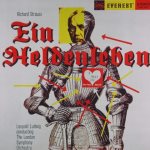
The
Richard Strauss disc next. The LSO are on guard for this recording rather than the LPO. The recording delivers a very well defined growl and grunt but the performance is not a headlong experience. It's a very controlled orchestral display piece in the hands of Leopold Ludwig. You can sense Ludwig shaping things with enormous care. The recording is his servant in this; it teases out the threads with great transparency. In a post-apocalyptic world where orchestral scores have been destroyed this recording could be used to reverse engineer the full score. The glow of the playing is not such as to obscure detail but is still packed with character. Not overwhelming then, but a performance to leave you thinking that this is likeable music - something I have not always been able to claim for
Heldenleben. Listen, for example, to the way the leaping main theme transforms in to alpine woodwind calls in the sixth and final section.
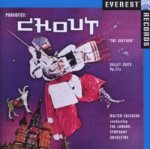 Prokofiev
Prokofiev's rare
Chout ballet is represented by a twelve-movement suite running to about 35 minutes.
Chout or
The Buffoon follows a grim and deeply politically incorrect fairy tale. The style adopted for this 1921 music is angular, torrential and
grand guignol, as befits the subject matter. There's little of the sweetness and enchantment of the First Violin Concerto or the simple blandishments of the
Classical Symphony. Prokofiev here is steely, slithering, gawky and he lets loose screes of metallic sound. Right-angled
ostinati abound with those angles accentuated by an indulgent array of percussion. There's something of the
Scythian Suite here but the score is more cleanly orchestrated. Stravinsky's
Rite (tr.10 1.24) and
Petrushka occasionally leap to mind. The trumpet in
The Merchant's Bedroom has a touch of
Kije about it. The Fifth entr'acte is both haunting and bone-chilling.
The Quarrel (tr.11) begins in relentless and raucous mode and settles soon into absurdist leaping and marching activity. This is music that pre-echoes Kurt Weill. The sound quality is remarkable. Would that all recordings of this vintage (August 1958) attained a similar standard. The extensive original notes are by David Hall.
The Prokofiev disc has been reviewed by
Dan Morgan
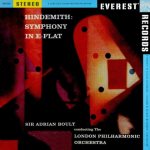
The Boult/LPO
Hindemith Symphony in E flat brings us full circle: to a conductor we hardly expect to hear in such repertoire although his long BBC years had him ranging far and wide. This disc offers the shortest playing time of any of these discs - less than thirty minutes. The recording team differs from that of the other four CDs here: Raoul Poliakin and Joe Kane. The results are quite thin and strident by comparison with the extraordinarily fruity and open results achieved during the same year and at the same London venue for the other discs. This is a conflict-ridden symphony and Boult does not short-change us in that direction. The results are eruptive but sadly are consistent with what we might have expected from middling- to lower-range results during that era. It had me thinking of the etiolated sound secured from Pye Golden Guinea LP in the 'sixties. Primary appeal will be to those wanting to have Boult's take on Hindemith. Regrettably, those on a nostalgia trip will not be astonished by the sound quality this time. I happened to have Herbert Kegel's Dresden recording of the Symphony to hand as part of a desirable Hindemith box (Brilliant Classics 9441). These recordings are from the last hurrah of analogue stock in the 1980s in East Germany. Kegel takes about three minutes longer overall than Boult. With the benefit of two decades of improved audio technology the DDR engineers produce something that is extremely agreeable to hear. Kegel drives this wartime work hard but it is not in the same league of ferocity as Boult.
There we have it. These Everest CDs are completely successful except in terms of playing time. They display sheer
élan and remarkable sound - except in the case of the Hindemith.
Rob Barnett
Overview of Everest CDs considered:-
SHOSTAKOVICH Symphony No. 6 - LPO/Boult SDBR 3007 [32:49]
ARNOLD Symphony 3; Scottish Dances - LPO/Arnold SDBR 3021 [44:18]
PROKOFIEV
Chout suite - LSO/Walter Susskind SDBR 3001 [33:11]
HINDEMITH Symphony in E flat - LSO/Boult SDBR 3008 [29:46]
STRAUSS
Heldenleben - LPO/Leopold Ludwig SDBR 3038 [34:05]
